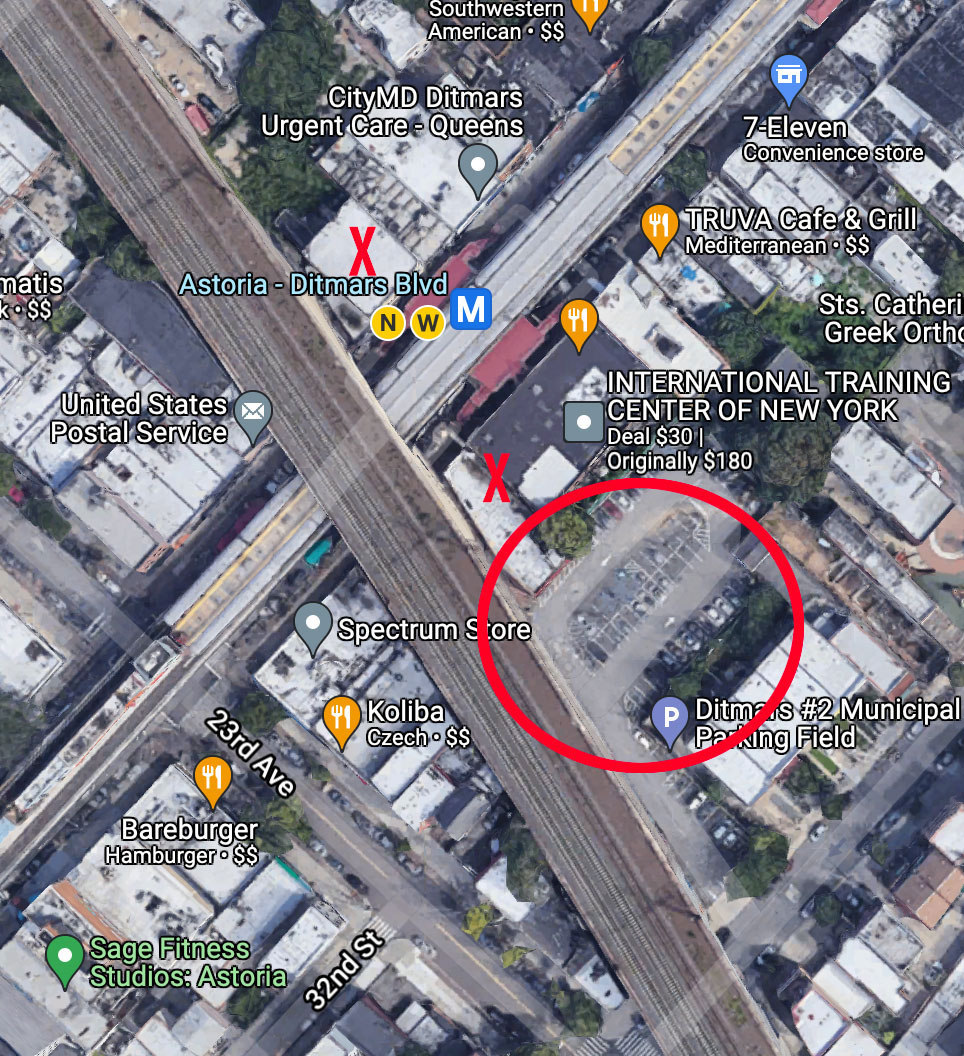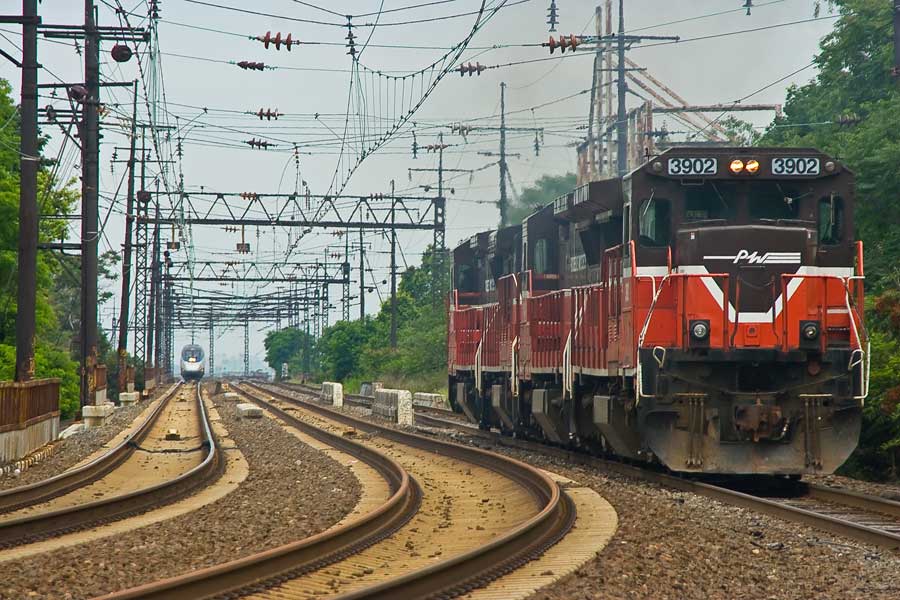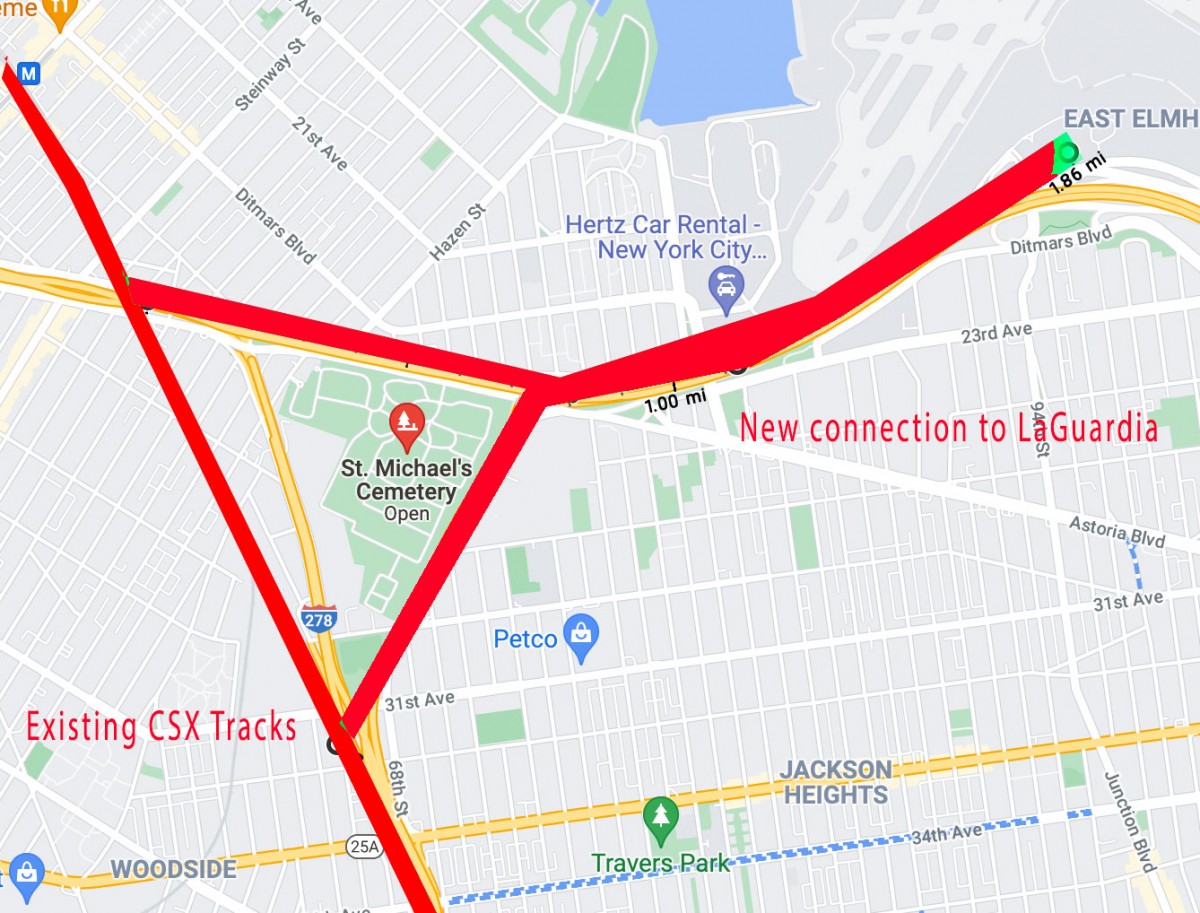
Nearly ten years ago, I wrote about the ‘Triboro RX’, a plan to bring passenger trains to the freight tracks of Queens, Brooklyn and the Bronx. That plan has never gone anywhere, until now. It has re-emerged as the “Inter-borough Express”—a plan to bring passenger trains to much of the same route, with the exception of running over Hell Gate bridge to the Bronx. The plan was introduced by New York State’s latest governor, Kathy Hochul, and came with a study conducted by the MTA and their consultants.
When I wrote about the Triboro RX, in 2013, I tore the plan to shreds. It deserved to be shredded. It has always been a great idea but a very weak plan. It begged for the critique. Critiques make designs stronger, and the Interborough express plan is definitely a stronger idea now. I’d be surprised if that’s not due in some small part to what I wrote.
So the new plan is a stronger plan, but it’s not quite there yet. I’m going to give the new ‘interborough express’ study a fast, stiff critique. If the governor’s office is wise, they’ll eat up every word of this. I’m sure AECOM would charge a million dollars for what I’m going to throw down right here for free.
For this critique, I will quote heavily from this NY1 article on the topic. Let’s go:
“Is it bus rapid transit? Is it light rail? Is it heavy rail?” Hochul said at a news conference. “We don’t have those answers today, but we know we have a path forward.”
Hi. I have an answer. The answer is “how much do you want this to cost?”
Bus rapid transit or light rail would require a deck to be built over many parts of the route, in order to separate non-FRA safety complaint vehicles with the very heavy freight trains that currently ply these tracks. The price tag for this, and the timeline to get it built, would be huge. In addition you’d have to hire a large number of bus drivers to move fewer people than you could by train. It’s a nice idea, but boy howdy it would cost billions—which would be a weird flex for an organization that has spent the last fifty years pleading poverty and regularly raising train fares.
Heavy rail, assuming you define that as FRA-compliant trains (like the ones Metro North and Long Island Rail Road uses) could make use of the existing (albeit heavily upgraded) tracks. To save even more money, they *could* use diesel or battery powered trains on this route. The LIRR is already experimenting with battery powered trains. If they run through to the Bronx, they could charge while running through electrified territory as far as New Haven (bringing back an air of this former New Haven Railroad’s former glory).
Using such trains shouldn’t lead anyone to assume commuters would have to pay Metro North or LIRR prices. A city pass that works across subways, LIRR & Metro North within city limits is long overdue. Tax landlords more. Institute congestion pricing. Who cares? Want to help save the planet? Get it done Hochul.
Let’s go back to that NY1 article: “Conventional rail trains could use the existing track, with a third rail power source added, while light rail would use overhead power lines.” – this quote is also not true. FRA compliant trains can be powered by diesel locomotives, batteries (an emerging technology that’s still under development), overhead power (see Metro North’s New Haven line) or third rail (Metro North, LIRR). There are plenty of options. Which one is going to be cost effective and the most environmentally friendly? That’s the real question. And if we go with electric trains, can someone, please for the love of god, cover every station and available space along the tracks with solar panels? The Con Ed cabal doesn’t need any more of our money.
The study document also contains one huge, glaring error that is just inexcusable. Here it is: “While most of the corridor only has one active freight track, the IBX alternatives would need to preserve space for two freight tracks to accommodate future growth in freight traffic on the corridor. The only point where that is not feasible is the East New York Tunnel, which does not have enough width for more than one freight track alongside the IBX. Barring the construction of an additional tunnel, this location could be a choke point for future freight traffic”
This is FALSE. The East New York freight tunnel was built for FOUR tracks. Don’t take my word for it. JUST LOOK AT IT.

In this photo you can see one track-less tunnel on the east side, one active freight track (lowered for added clearance in the 1980s), a second freight track (currently used for storage) and a fourth, bricked over trackway that currently hosts a small pipeline. Move the pipe and you’ve got four tracks. More than enough for freight and passenger trains. That’s actually how this tunnel functioned until the 1920s. It still contains an abandoned passenger station on it’s south end. Just look at the photo below.
IDK call me crazy but if the consultants who wrote this latest study can’t get an extremely simple fact like this one correct, maybe the MTA should look to some actual experts to advice them on this (and other) projects. We’re not hard to find.

The actual choke point is the entire Fresh Pond Junction/Fremont yard to the north of the tunnel. It’s congested and packed with freight cars. Running passenger trains through this yard will require some major changes and added freight tracks elsewhere. This problem is as true today as when I first explained it in 2013. Let’s talk about real, existing problems, and how to solve them. I’m 100% sure additional track capacity could be built somewhere else to solve this riddle.
The missing 4000
While we’re mocking this latest report for a minute, check out this line: “The study projects that the Interborough Express would ferry 10,000 riders from Queens to Brooklyn daily, with 6,000 riders going the other direction. “
So… 4000 queens residents just disappear into Brooklyn every day? If I just did my math right, the entire 2,405,464 population of Queens would empty out into Brooklyn using these tracks within two years. Does the governor and Mr. Swagger have a plan for where 2.4M people will live in Brooklyn? Or what they’ll do with an empty Queens?
Yes I’m cracking a joke here, but also, how can anyone take these studies seriously when they spout this nonsense? Where did they get these numbers? What are they based off of? And where did those 4000 people go? Seriously? Don’t give people like me numbers without showing your sources in complete detail.
Connection to the Bronx. Why not?
For my final critique, let’s tackle this studies huge, flawed thesis about running trains to the Bronx: “The study suggests that extending the line through Astoria, Randalls Island and across the Bronx — a central component of the original concept for the three-borough line — would see significant challenges. The MTA would need to build a new train line, as existing rails along the route could not accommodate the anticipated 5-minute headways on the Brooklyn-Queens line. The extension would also require significant property purchases, whereas the Brooklyn-Queens section has an existing right-of-way on already-built tracks.”
That’s a lot to digest, but if you read what I wrote nearly ten years ago, you wouldn’t be surprised by this conclusion. At the time I wrote about what it would take to expand the viaduct through Astoria: “To expand the viaduct would mean the condemnation and demolition of up to 85 homes along the viaduct, along with at least one church and the Astoria 11105 Post Office. Most of these 85 homes are currently valued in the 700-900k dollar range (2013 prices – these go up every year by at least 50k). After demolition, you’ve just spend at least 85 million just to create space for the wider viaduct – not including all the lawsuits, police overtime at protests, etc. The cost of iron, new wider bridge piers, etc would run into the billions. And this is for maybe a 2 mile segment of the route!”
Additionally, to build a new stop connecting to the N/W trains, you’d have to close Ditmars Blvd stop for a long time. Since Ditmars is the terminal of the Astoria elevated line, and there’s nowhere else to turn subways, they’d probably have to cut off service to the entire Astoria elevated, terminating the N and Queens Plaza. So yeah there would have to be modifications to the current route (switches and a temporary terminal at Astoria Blvd) or shuttle buses. Like, a lot of shuttle buses. Hundreds of shuttle buses.
So, uh, yeah I can see how the latest MTA study would conclude that it would just plain cost way way too much money to run from Queens to the Bronx. BUT… is it? Did they base this decision off what a very snarky, very correct me wrote nearly ten years ago? Because it sure as f*ck looks that way.
Factually, in terms of cost and social unrest, I stand by by words. However, this is where I admit to a lack of imagination ten years ago. There are options.
Maybe not build this one station?
The Inter-Borough Express and N/W subway transfer would be great – but does it need to exist? If this is the only thing holding the extension back, should it? I would say no. Rebuild CSX’s track over Hell Gate. Relay the 4th track (that was taken out in the early 80s), run trains. Run trains all the way to New Haven. Why not? FRA complaint trains, on the same freight track CSX uses. This is 100% possible at a minimal cost.
The only current physical blocker to running trains to the Bronx is the CSX interchange. For those that don’t know, CSX and New York & Atlantic (which moves freight across Brooklyn, Queens and Long Island), now swap train cars in Woodside (they used to do that at Fresh Pond, but again, it’s too congested). CSX owns the tracks. They could just sell them to the MTA, and New York and Atlantic could bring those cars up to the Bronx. THIS ISN’T ROCKET SCIENCE.
Maybe build it, knowing it’s not going to be perfect?
That said, let’s get back to our Ditmars transfer. What if the passenger tracks were just a single track through the station, allowing space for a platform? Sure, timing would be a thing, but the MTA manages this just fine in parts of the existing system. Just look at the junction where the M branches off from the J line. Sure it’s less than ideal, and hurts capacity to a degree. But you want to know what would truly kill capacity? Not running the train at all.
What if this station was just a single platform added on to the north side, with two tracks running through and only one used for the stop? It would be less than ideal, but a transfer in one direction is better than zero transfers in either direction.
In my 2013 assessment, I stated widening the viaduct for 5 tracks would involve condemning and demolishing nearly a hundred homes in Astoria. But if we run FRA complaint trains on just two tracks, which Hell Gate bridge was designed to accommodate without costing anyone a dime today—that cost—and that destruction-doesn’t take place at all. In fact, to build a single track transfer station at Ditmars, they could minimize demolition to just one or two buildings, leveraging the existing parking lot between 31st and 33rd streets as space for a transfer building. The city owns that parking lot. Minimal property purchases needed.

The Red X’s represent buildings that would need to be demolished. The Big Red circle is a city owned parking lot. A perfect place for a very grand transfer building.
Additional options include adding switches at Bowery Bay Junction (where the present day freight tracks and Amtrak split), which would allow freight trains to roll on Amtrak’s tracks over the bridge, and vice versa. There are options to make this connection happen. They would require a lot of work , but what are problems if not for solving? One small step at a time?
Maybe if this transfer is hugely popular, maybe it requires a ton of planning and some property purchases around the 31st street area. Again, problems want solutions. it would be messy, but it could get done, without building entire additional tracks (or any additional bridge and viaduct).

Running trains up to and through the Bronx would have HUGE benefits. The study assumes they can build a storage yard at 65th street in Brooklyn. That yard is already packed with freight. By running passenger trains all the way through the Bronx, the could leverage existing Metro North shops and expand storage yards up north, where there is more property available. It would also serve the people of the Bronx. Don’t they deserve better transit too? This becomes a social justice issue once you start excluding populations for dubious reasons.
A footnote here on social justice: There are a few long term residents of these tracks, who have lived in discreet, hidden camps along this route. Some have lived there for over ten years. Needless to say these people should be provided with proper housing.
In conclusion, there’s no valid reason why this train can’t go to the Bronx. A transfer at Ditmars would be problematic, but not impossible. Yes, CSX owns the tracks, but they have sold tracks for transit use before, so long as their access to move freight was guaranteed. Just last year they sold a key in their network route to the state of Virginia. They are a for-profit corporation. While they make bank moving freight in and out of NYC, they could still make that bank and not pay for maintaining the tracks. Then New York State could better control their destiny on this route.
LaGuardia connection

While we’re here, a whole new branch could be built above the Grand Central Parkway, providing a rail connection to LaGuardia Airport. It’s a mere two miles away, and a viaduct could be placed directly over existing highways, eliminating the cost of buying property. If Cuomo could scare up money for his backwards Air Train plan, I’m sure we can find money for this—a connection that would give residents from across the entire city (and Westchester even) access to the airport.
So that’s my critique. The Interborough Express plan is far, far better than the navel gazing, fantasy based “Triboro RX’ plan simply because it acknowledges some existing constraints and looks for paths forward. That’s huge. That’s the reality-based mindset that could get this job done. Look for the paths forward. They are there, screaming to be noticed.
From here forward, it’s just a matter of costs. The cheapest, simplest option, diesel or battery hauled FRA Complaint trains, could be implemented within five years. If I had to hazard a guess, I’d say a billion dollars to get this done. A low price tag would be great, because it would allow more money to take up other equally deserving transit projects, like reopening the tracks for QueensLink.
The other options—decking over tracks for light rail, adding third rails or overhead power, figuring out how to deal with a transfer at Ditmars… all those things add up cost. That decking idea looks great but we’re now talking billions to make this route happen, and adding years upon years to the construction timeline. Does NYC really have time for that? Does our planet have time for that? Adding this transit route would be huge for NYC’s efforts to get more people out of cars, and to create a safer, more ecologically friendly city. I’m 100% all for it. Now let’s figure out the details, without making it so expensive and time consuming that it never gets done. Wouldn’t that be nice? To actually build something for a reasonable amount of money? To actually get the job done in our lifetimes? To not recreate another long delayed money pit, like the East Side Access and Second Avenue Stubway projects?
The governor has an opportunity here to actually get something done. Assuming she’s re-elected, and she plays her cards right (and actually listens to us advocates), she could find herself cutting the ribbon on this thing while still in office.
I don’t care whose ego gets stroked. Let’s just get this done already. NYC needs it.
I have sent an annotated 24 page memorandum of comments to the MTA on the proposed Interborough Express project, including suggestions for use of battery-powered railcars, on the mode and on coordination with freight. It should be useful in your continuing coverage. I can send you a copy by Email if you provide an address.
I understand, from communications with the MTA, that it expects to receive a further report from its consultants regarding the recommended mode of operation of the Interborough Express by the end of September.
In the course of my study, I have made a FOIL request for the detailed feasibility study, which I now expect to receive by September 1st. I also have made a FOIL request for the MTA’s study of feasibility of battery-powered railcars for the LIRR Oyster Bay branch, which was completed in February. The MTA’s response to that request is overdue.